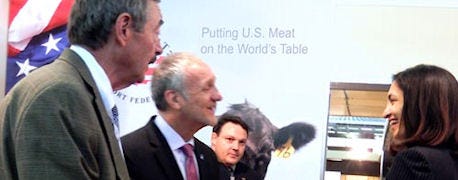October 22, 2014

Billed as one of the largest international food shows in the world, SIAL 2014 in Paris is an outstanding venue for showcasing U.S. beef and pork, the U.S. Meat Export Federation says.
USMEF participates in SIAL through support from the USDA Market Access Program.
About 150,000 participants from more than 100 countries are in attendance at the five-day event. A majority of those attending are from the European Union, but SIAL also attracts a large number of buyers and other food industry professionals from Russia, the Middle East and many Asian countries including Japan and China.

Uzra Zeya (right), chargé d'affaires at the U.S. Embassy in Paris, meets with USMEF members at the SIAL 2014 trade show. Pictured from left to right are Mark Gustafson of JBS, Steve Isaf of Interra International and Juliano Jubileu of JBS.
"U.S. beef and pork are strongly represented at SIAL," said Dan Halstrom, USMEF senior vice president of marketing and communications. "We have [non-hormone treated cattle] approved suppliers here on the beef side, but we also have several pork packers in attendance and a large number of traders and purveyors as well."
Steve Isaf, president of Interra International and past chairman of USMEF, agrees.
"The European meat trade is going through a volatile and somewhat difficult period," Isaf said. "Yet interest from buyers has been very strong this week. Despite a number of trade issues that make this a challenging region in which to do business, it can still deliver very solid returns for exporters."
U.S. beef exports to the Europe have been growing under the EU's duty-free high-quality beef quota. But heavy utilization of the quota by other beef-exporting countries – especially Australia and Uruguay – have both suppliers and importers concerned that the HQB quota no longer has enough capacity to accommodate current demand.
Related: Hot Global Pork Markets Poised for Cool Down
"Without question, this is a major concern here at SIAL," said John Brook, USMEF regional director for Europe, Russia and the Middle East. "For July through September, the quarterly allocation of the HQB quota was nearly fully utilized, causing some importers to delay shipments into October. Import activity has been very heavy since the new quarter began, putting us on a pace that could cause capacity concerns to resurface as early as November."
~~~PAGE_BREAK_HERE~~~
Europe always has a high degree of self-sufficiency in pork production, and Russia's current ban on pork imports from the EU (in place since January, due to African swine fever) has significantly depressed the European pork market – making it an even tougher environment for imports. But Halstrom says it is important to view the market from a long-term standpoint.
"Europe is a customer of ours, but also an important competitor – especially on the pork side," he explained. "Right now we're seeing a lot of inexpensive European pork in both the international marketplace and within the domestic EU market, but prices and market conditions are going to normalize over time. When that time comes, it's important for U.S. suppliers to be well-positioned to capitalize on new opportunities."
Related: Fast-filling Import Quota Could Slow U.S. Beef Exports to EU
In addition to the EU-Russia pork impasse that has now lasted nearly nine months, Russia has also been closed to most pork and beef products from the EU, the United States and Canada since early August.
This week Russia also imposed a ban on beef offal and all animal fat from the EU, dampening hopes that trade relations will improve anytime soon. This is a prime topic of discussion at SIAL, because the impact extends well beyond Russia's borders.
~~~PAGE_BREAK_HERE~~~
"Russian buyers are still very interested in U.S. pork and beef, and it's unfortunate that we are presently unable to serve them," Brook said. "But USMEF remains active in the Greater Russia region, where we certainly see opportunities emerging in the markets that are still open to U.S. products. Some of those countries are now exporting more meat to Russia, which can open new doors for U.S. suppliers."
Buyers from the Middle East are typically well-represented at SIAL, and Halstrom noted that this year is no exception.
Related: Meat Export Values Increased in August Despite Lower Volume
"All of the major Middle Eastern destinations are represented," he said. "Egypt has a large number of buyers present, along with the United Arab Emirates, Jordan and Qatar. These are excellent growth markets for U.S. beef, but also exceptionally competitive – so SIAL provides a great opportunity to connect with prospective customers from that region."
With more than 6,300 exhibitors participating in SIAL, competition for buyers' attention has never been more intense. In addition to the strong showing of vendors from North and South America, Europe and Australia, Asian suppliers also have a growing presence at SIAL.
"This is part of Japan's new focus on exporting high-value products, such as wagyu beef, to customers in Europe and other international markets," Brook explained. "SIAL has a strong reputation for generating new business, which captures the attention of suppliers from across the world."
Source: USMEF
You May Also Like




